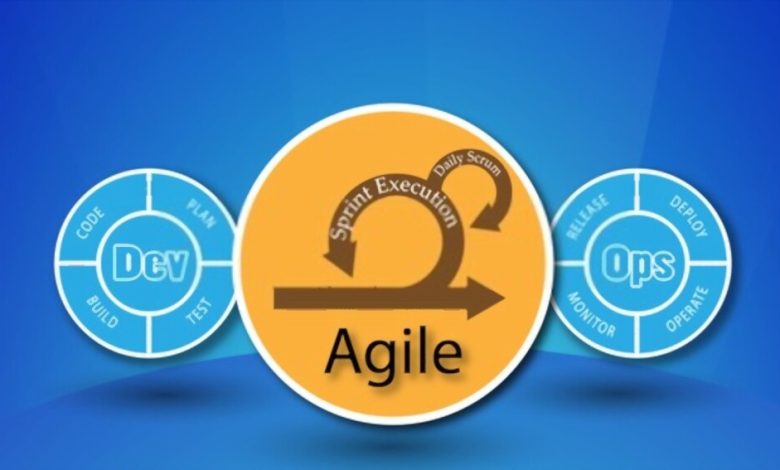Merging Agile and DevOps: The Best of Both Wolds

We all know the importance of implementing agile methodologies in our software development initiatives. But delivery is not the core of a development initiative. A software development project includes several other minor and mission-critical processes, and all of these processes contribute to the project’s success. When you combine Agile and DevOps, your development initiative is poised to achieve an optimal balance between effort and output.
IT operations generally involve the following operations: services desk, requests, strategy, facility management and administration, asset and infrastructure management, network management, and system management. These operations cover the software being developed both before and post-deployment. Some additional operations are deployment, configuration, performance monitoring, risk management, and testing.
For your development initiative to run smoothly, we advise a combination of both Agile and DevOps implementation services. Read on for all you need to know about how and why to combine agile with DevOps in your software development initiative-
Benefits of using Agile and DevOps
The DevOps culture focuses on service delivery and system interaction. Given the value it offers customers and clients, this is a high-priority process. Some of the benefits of using DevOps with Agile are as follows-
- Combining agile with DevOps allows your team to innovate faster while offering the flexibility and adaptability required to match evolving market needs. This flexibility also speeds up the pace of development in terms of both volume and frequency of releases. The faster feature releases are, the faster your response to changing customer demands and feedback.
- Concepts like CI/CD, automation, etc., can help manage complicated systems, development processes, and infrastructural requirements. It also allows you to stay in the loop regarding real-time performance thanks to capabilities like logging and monitoring.
- Merging agile and DevOps results in enhanced levels of collaboration between developers and operations teams, given that this methodology allows responsibility sharing and augments ownership and accountability. As a side note, it also saves a ton of time.
- You can achieve enhanced security levels thanks to the merging of DevOps and agile and the resulting automation and configuration management systems. Preserving compliance and retaining nuanced control also becomes a lot easier.
- The combination of quality software delivered in shorter release cycles immediately offers a positive customer experience. Automation also ensures asset stability after each incremental release/update.
How to Implement DevOps in an Agile Team
So far, we have covered the benefits of implementing a combination of DevOps services and agile in your SDLC. Now we are faced with the question of how to do so. Enumerated below are seven essential principles to facilitate a DevOps + Agile software delivery process.
1. Automate
Your SDLC may still function with several manual processes like deployment, testing handoffs, etc. To access the full benefit of DevOps + Agile, automate everything you can. Testing, integration, unit, code scanning, workflows, and releases can all be automated with high success rates for the software being developed.
2. Continuous Integration (CI)
The methodology/process of continuous integration is common to both agile and DevOps. CI involves building source code and integrating team development efforts to create a deployable product continuously being improved in real-time. Every time a source code is committed, static code analysis is complemented by security scans that help address and mitigate merge conflicts.
3. Continuous Delivery/Continuous Deployment (CD)
Continuous delivery is yet another mission-critical aspect of both DevOps and agile. By automating the continuous delivery process that produces working software in super-short cycles, you can automatically access input from CI, combine it with pertinent modules, builds, tests, etc., to achieve frequent releases.
4. Improve Teamwork Flow
Having your entire team on the same page is essential for successful software development. Stakeholders like the product owner, scrum master, developers, system admins, ops teams, and managers should be well-equipped with all the required tech and infrastructural tools and expertise to facilitate and deliver releases, services, maintenance, and deployment.
5. Find and Eliminate Hot Spots
Hotspots are parts of the code that are executed most often. Given their high execution numbers, hot spots can negatively impact the speed and performance of the product being developed. It is suggested to implement aligned tools and instrumentation to locate and fix such bottlenecks.
6. Adopt DevOps in Sprints
One of the primary principles of agile is to divide the software development process into ‘sprints,’ predefined timeframes in which a specific goal is expected. Sprints facilitate an iterative approach to development and delivery. When DevOps is combined with agile, DevOps methodologies should trickle down to each sprint for optimal results. Bringing in operations and support teams into planning sessions, stand-ups, reviews, and scrum meetings can help developers strategize a realistic release Schedule which will subsequently result in enhanced collaboration and faster product shipping
7. Include QA in Each Phase
QA or Quality Assurance is a process that monitors and ensures the quality of the services/products. QA significantly improves the development process by clearly dictating expected quality standards. Given that both agile and DevOps sport processes like CI and CD, having QA testing in place for each phase can exponentially enhance the product/service’s value proposition on both sides of the table.
How does DevOps Enable Agile Organizations?
The implementation of an agile approach to software development is now very popular. Since continuous integration results in multiple modules for frequent releases thought leaders built the DevOps methodology to automate and ‘cut the fat’ of the SDLC to streamline the process. Some of the benefits that DevOps Services can offer are:
- DevOps Implementation facilitates a self-sustaining development framework that offers continuous feedback, which is highly desirable in agile workflows.
- Implementing CI/CD significantly reduces the time taken to build and deliver software products.
- With DevOps, teams can establish trails for all releases, updates, and deployments.
- Tracking and resolving issues and incidents becomes easier thanks to comprehensive monitoring tools.
Conclusion
Agile focuses more on the actual development, while DevOps is more of a testing and delivery methodology. When combined, DevOps and agile enhance software delivery capabilities, resulting in faster releases, enhanced collaboration, better security, higher levels of customer satisfaction, and stability.
At its core, DevOps is a combination of Agile and CI that helps build software systems that emphasize collaboration across stakeholders. We trust that this article will prove informative. Until next time, happy developing!






